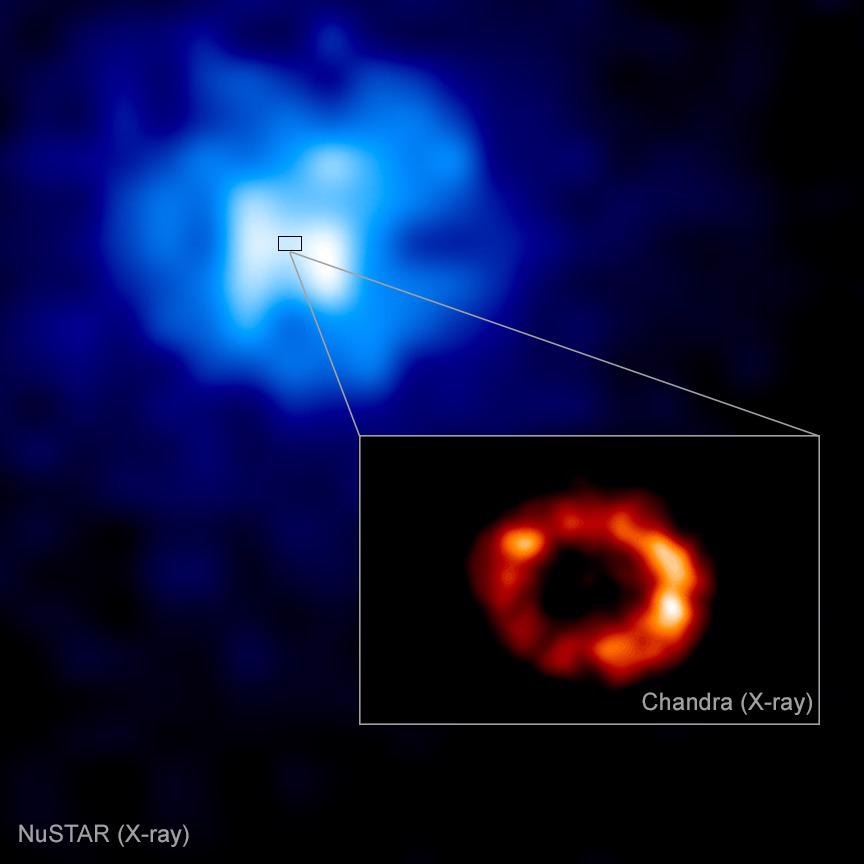Feb 24 2021
For more than 30 years, researchers have been searching for a reclusive neutron star in the famous Supernova 1987A (SN 1987A). Now, astronomers have found proof for the existence of this star at the core of this supernova.
 NuSTAR and Chandra images of Supernova 1987A. Image Credit: Chandra X-ray Observatory.
NuSTAR and Chandra images of Supernova 1987A. Image Credit: Chandra X-ray Observatory.
As described in the latest press release, SN 1987A was detected on February 24th, 1987. In the above images, the panel on the left depicts a 3D computer simulation, based on the data obtained from the Chandra X-ray telescope, of the supernova remnant from SN 1987A colliding into a surrounding ring of material.
The right panel of the image shows the artist’s illustration of a so-called pulsar wind nebula, a network of energy and particles exploded by a pulsar, which is a highly magnetized, rotating neutron star. Data obtained from NuSTAR and NASA’s Chandra X-ray Observatory in a recent study supports the existence of a pulsar wind nebula at the core of the ring.
If this finding is supported by upcoming observations, it would validate the presence of a neutron star in SN 1987A—the disintegrated core, which according to astronomers, would be present following the explosion of the star. Moreover, the pulsar would be the youngest one to ever be detected.
Upon explosion, a star collapses onto itself before the exterior layers explode into space. The compression of the center of the explosion becomes an unusually dense object, with the Sun’s mass closely packed into an object that measures just around 10 miles across.
Neutron stars are laboratories of extreme physics that can never be replicated on planet Earth, and they got their names because they are almost exclusively made of densely packed neutrons.
Certain neutron stars have powerful magnetic fields and rotate quickly, creating a light beam similar to a lighthouse. These objects are referred to as “pulsars” by astronomers and they occasionally blow winds of charged particles that can generate pulsar wind nebulas.
Using Chandra and NuSTAR X-ray telescopes, the researchers identified comparatively low-energy X-rays emitted from the supernova remnant colliding into the surrounding material. Using NuSTAR’s potential to spot higher-energy X-rays, the researchers also discovered evidence of high-energy particles.
This energetic X-ray emission provides two possible explanations—either particles being expedited to high energies by the blast wave of the explosion, or a pulsar wind nebula. The former effect does not demand the presence of a pulsar and takes place across relatively larger distances from the core of the explosion.
The new X-ray study upholds the case for the pulsar wind nebula on two aspects. Firstly, the brightness of the higher energy X-rays continued to remain almost the same from 2012 to 2014, whereas the radio emission increased. But this is contrary to the expectations in the case of energetic particles in the explosion remnant.
The team then estimated that it would take nearly 400 years to speed up the electrons up to the maximum energies observed in the NuSTAR data, which is more than 10 times older than the age of the debris.
The NuSTAR and Chandra data also upheld a 2020 finding from the Atacama Large Millimeter Array (ALMA) that offered potential proof about the structure of a pulsar wind nebula present in the radio band. Although there are other possible explanations for this “blob”, its discovery as a pulsar wind nebula could be validated with the latest X-ray data.
Gas and dust surround the core of SN 1987A. Using advanced simulations, the authors set out to figure out how this material would be able to absorb X-rays at varying energies, allowing a more precise understanding of the X-ray spectrum, in other words, the spread of X-rays across wavelength. This allows the researchers to predict how the spectrum of the core areas of SN 1987A would appear without the concealing material.
An article explaining these outcomes will soon be published in The Astrophysical Journal and a preprint is also available online. The study authors are Emanuele Greco and Marco Miceli (University of Palermo in Italy), Salvatore Orlando, Barbara Olmi, and Fabrizio Bocchino (Palermo Astronomical Observatory, a National Institute for Astrophysics (INAF), research facility); Shigehiro Nagataki and Masaomi Ono (Astrophysical Big Bang Laboratory, RIKEN in Japan); Akira Dohi (Kyushu University in Japan), and Giovanni Peres (University of Palermo).
The Marshall Space Flight Center at NASA controls the Chandra program. The Chandra X-ray Center at the Smithsonian Astrophysical Observatory manages science from Cambridge Massachusetts and flight operations from Burlington in Massachusetts.
NuSTAR is a Small Explorer mission headed by Caltech and handled by NASA’s Jet Propulsion Laboratory for the agency’s Science Mission Directorate in Washington. NuSTAR was created in association with the Danish Technical University and the Italian Space Agency (ASI).
The spacecraft was constructed by Orbital Sciences Corporation in Dulles, Virginia (currently a part of Northrop Grumman). The mission operations center of NuSTAR is located at UC Berkeley, and the official data archive is based at NASA’s High Energy Astrophysics Science Archive Research Center. ASI also offers the mission’s ground station and a mirror archive. JPL is a division of Caltech.